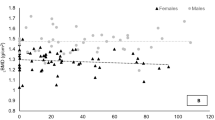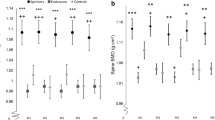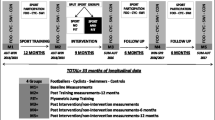Abstract
The attainment of optimal peak bone mass during adolescence is important in the primary prevention of osteoporosis. Exercise may contribute to skeletal development and bone density during growth, although competitive exercise is suggested to have an adverse effect. This study assesses the effect of moderate exercise on the bone density of adolescent females. Additionally, other factors which significantly influence attainment of peak bone mass were identified. This was a cross-sectional study of 42 adolescent females, classified as runners (n=15) or non-runners (n=27). Nutrient intake, energy expenditure, menstrual history and pubertal stage were recorded. Bone age, skinfold thickness, body composition and bone mineral density (BMD) of total body, lumbar spine and proximal femur were measured. Statistical analyses used Student's t-test, Pearson correlation and multiple regression analyses. Runners had lower fat mass and higher lean mass, with a trend to higher BMD in all sites measured. There were no significant differences in menstrual cycle regularity, age at menarche or number who had attained menarche. Pubic hair development was similar in both groups. Breast development was delayed in runners, although this may have been a function of lower fat mass in this group. When subjects were categorized according to menarchal status, postmenarchal girls were significantly taller and heavier, with higher fat mass and significantly higher total body and lumbar spine BMD. There was no significant relationship between BMD at any site and dietary nutrient intake. Multiple regression analyses, using BMD as the dependent variable, identified running status, pubertal stage, fat mass and lean mass as significant determinants. When BMD/height was used, significant determinants in total body BMD were fat mass, pubertal stage and running status, while in the lumbar spine, only the latter two variables remained significant. In conclusion, body composition, physical activity and sexual maturity were identified as significant determinants of bone density during adolescence. Runners had significantly lower body fat than non-runners, but this did not interfere with hormonal cyclicity, and caused no detriment to their bone density. The results of this study are reassuring, since they indicate that sub-elite competitive athletics has no detrimental effect on bone mass accrual in adolescent females.
Similar content being viewed by others
References
Bass S, Pearce G, Bradney M et al. (1998) Exercise before puberty may confer residual benefits in bone density in adulthood: studies in active prepubertal and retired female gymnasts. J Bone Miner Res 13:500–507
Arena B, Maffuli N, Maffuli F, Morleo MA (1995) Reproductive hormones and menstrual changes with exercise in female athletes. Sports Med 19:278–287
Duke PM, Litt IF, Gross RT (1980) Adolescents' self-assessment of sexual maturation. Pediatrics 66:918–920
Reid IR, Evans MC, Ames RW (1994) Volumetric bone density of the lumbar spine is related to fat mass but not lean mass in normal postmenopausal women. Osteoporos Int 4:362–367
Carter DR, Bouxsein ML, Marcus R (1992) New approaches for interpreting projected bone densitometry data. J Bone Miner Res 7:137–45
Ainsworth BE, Haskell WL, Leon AS et al. (1993) Compendium of physical activities: classification of energy costs of human physical activities. Med Sci Sports Exerc 25:71–80
Kleinbaum DG, Kupper LL, Muller KE (1988) Applied Regression analysis and other multivariable methods, 2nd edn. Duxberry Press, Belmont
Slemenda CW, Miller JZ, Hui SL et al. (1991) Role of physical activity in the development of skeletal mass in children. J Bone Miner Res 6:1227–1233
Ruiz JC, Mandel C, Garabedian M (1995) Influence of spontaneous calcium intake and physical exercise on the vertebral and femoral bone mineral density of children and adolescents. J Bone Miner Res 10:675–681
Lehtonen-Veromaa M, Mottonen T, Irjala K, Nuotio I, Leino A, Viikari J (2000) A 1-year prospective study on the relationship between physical activity, markers of bone metabolism and bone acquisition in peripubertal girls. J Clin Endocrinol Metab 85:3726–3373
MacKelvie KJ, McKay HA, Khan KM, Crocker PRE (2001) A school-based exercise intervention augments bone mineral accrual in early pubertal girls. J Pediatr 139:501–508
Cooper C, Cawley M, Bhalla A et al. (1995) Childhood growth, physical activity and peak bone mass in women. J Bone Miner Res 10:940–947
Teegarden D, Proulx WR, Martin BR et al. (1995) Peak bone mass in young women. J Bone Miner Res 10:711–715
Smith EL, Gilligan C (1996) Dose-response relationship between physical loading and mechanical competence of bone. Bone 18:45s–49s
Bourrin S, Palle S, Pupier R et al. (1995) Effect of physical training on bone adaptation in three zones of the rat tibia. J Bone Miner Res 10:1745–1752
Lanyon LE (1996) Using functional loading to influence bone mass and architecture: objectives, mechanisms and relationship with estrogen of the mechanically adaptive process in bone. Bone 18:37s–43s
Heinrich CH, Going B, Pamenter RW et al. (1990) Bone mineral content of cyclically menstruating female resistance and endurance trained athletes. Med Sci Sports Exerc 22:558–563
Petit MA, McKay HA, MacKelvie KJ, Heinonen A, Khan KM, Beck TJ (2002) A randomized school-based jumping intervention confers site and maturity-specific benefits on bone structural properties in girls: a hip structural analysis. J Bone Miner Res 17:363–372
Theintz G, Buch B, Rizzoli R et al. (1992) Longitudinal monitoring of bone mass accumulation in healthy adolescents: evidence for a marked reduction after 16 years of age at the levels of lumbar spine and femoral neck in female subjects. J Clin Endocrinol Metab 75:1060–1065
Slemenda CW, Reister TK, Hui SL et al. (1994) Influences on skeletal mineralization in children and adolescents: evidence for varying effects of skeletal maturation and physical activity. J Pediatr 125:201–207
Khan K, McKay HA, Haapasalo H, Bennell KL, Forwood MR, Kannus P, Wark JD (2000) Does childhood and adolescence provide a unique opportunity for exercise to strengthen the skeleton? J Sci Med Sport 3:150–164
Moyeur-Mileur L, Xie B, Ball S, Bainbridge C, Stadler D, Jee WS (2001) Predictors of bone mass by peripheral quantitative computed tomography in early adolescent girls. J Clin Densitom 4:313–323
Houtkooper LB, Ritenbaugh C, Aickin M et al. (1995) Nutrients, body composition and exercise are related to change in bone mineral density in premenopausal women. J Nutr 125:1229–1237
Reid IR, Ames RW, Evans MC et al. (1992) Determinants of total body and regional bone mineral density in postmenopausal women—a key role for fat mass. J Clin Endocrinol Metab 75:45–51
Reid IR, Legge M, Stapleton JP et al. (1995) Regular exercise dissociates fat mass and bone density in premenopausal women. J Clin Endocrinol Metab 80:1764–1768
Cornish J, Callon KE, Bava U, Lin C, Naot D, Hill BL, Grey AB, Broom N, Myers DE, Nicholson GC, Reid IR (2002) Leptin directly regulates bone cell function in vitro and reduces bone fragility in vivo. J Endocrinol 175:405–415
Goulding A, Taylor RW, Jones IE et al. (2000) Overweight and obese children have low bone mass and area for their weight. Int J Obes Rel Metab Dis 24:627–632
Baer JT, Taper LJ, Gwazdauskas FG et al. (1992) Diet, hormonal and metabolic factors affecting bone mineral density in adolescent amenorrheic and eumenorrheic female runners. J Sports Med Phys Fit 32:51–58
Matokovic V, Fontana D, Tominac C, Chesnut CH (1990) Factors that influence peak bone mass formation: a study of calcium balance and the inheritance of bone mass in adolescent females. Am J Clin Nutr 52:878–888
Delistraty DA, Reisman EJ, Snipes M (1992) A physiological and nutritional profile of young female figure skaters. J Sports Med Phys Fit 32:149–155
O'Brien KO, Abrams SA, Liang LK et al. (1996) Increased efficiency of calcium absorption during short periods of inadequate calcium intake in girls. Am J Clin Nutr 63:579–583
Lee WT, Leung SS, Tsang HS et al. (1995) A randomised double-blind controlled calcium supplementation trial, and bone and height acquisition in children. Br J Nutr 74:125–139
Lloyd T, Andon MB, Rollings N et al. (1993) Calcium supplementation and bone mineral density in adolescent girls. JAMA 270:841–844
Malina RM (1983) Menarche in athletes: a synthesis and hypothesis. Ann Hum Biol 10:1–24
Stanton WR, Kelly JL, Bunyan DA, Silva PA (1992) Expected gain in body mass and onset of menarche. Aust N Z J Obstet Gynaecol 32:338–340
Scott EC, Johnston FE (1982) Critical fat, menarche, and the maintenance of menstrual cycles: a critical review. J Adolesc Health Care 2:249–260
Engelbregt MJ, van Weissenbruch MM, Popp-Snijders C et al. (2001) Body mass index, body composition, and leptin at onset of puberty in male and female rats after intrauterine growth retardation and after early postnatal food restriction. Pediatr Res 50:474–478
Gaughan JB, Cameron RD, Dryden GM, Young BA (1997) Effect of body composition at selection on reproductive development in large white gilts. J Anim Sci 75:1764–1772
Acknowledgements
The authors are grateful to Susan Sharpe, Department of Medicine, University of Auckland, for help with the dietary analyses. This study was funded by the Health Research Council of New Zealand. J.A.L. and P.R.L. contributed equally to this work.
Author information
Authors and Affiliations
Corresponding author
Rights and permissions
About this article
Cite this article
Lucas, J.A., Lucas, P.R., Vogel, S. et al. Effect of sub-elite competitive running on bone density, body composition and sexual maturity of adolescent females. Osteoporos Int 14, 848–856 (2003). https://doi.org/10.1007/s00198-003-1455-7
Received:
Accepted:
Published:
Issue Date:
DOI: https://doi.org/10.1007/s00198-003-1455-7




